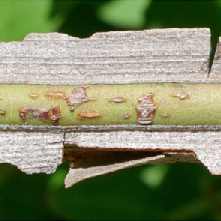With just about a month before millions of leaves and flowers become a distraction, now is the time to spend as much time as possible enjoying winter bark. Bark is at its most dramatic in the winter—the colors more intense, the shadows and relief of textured bark at their best with the low angle of the sun. For the last two months, I have walked the grounds of the Arnold Arboretum in search of great bark. On offer have been the eye-popping colors of snakebark maples (next Post), the incredible curls of shagbark hickory and Baker cypress, and the puzzle-piece patterns of stewartia, kousa dogwood, sycamore, and the Persian ironwood.
Today, I offer a personal favorite form of bark: winged bark (defined rather loosely). For reasons completely unknown to me or anyone else, certain trees have bark that proliferates in narrow panels along the stem. A classic example is the winged wahoo (Euonymus alatus, 14543*B, middle left), regrettably a highly invasive species in the eastern United States. Similarly, delicate winged bark also can be found in Fraxinus quadrangulata (blue ash, 832-2016*B, bottom image). The one winged elm (Ulmus alata) on the grounds is sadly wingless, but new material collected in the wild last fall in Georgia is growing in the propagation greenhouses and should impress soon.

The Miyabe maple (Acer miyabei, 286-2008*A, upper left) and closely related field maple (Acer campestre), the bur oak (Quercus macrocarpa, 279-2000*C, is a great example), and the American sweetgum (Liquidambar styraciflua, 1248-79*B, upper right) tend to form more robust corky ridges on younger stems. Finally, in some trees, bark becomes more irregular and “winged” with age. This is especially true of the hackberries (genus Celtis) which present some of the most topographical bark one can imagine. The middle right image is a small sample of what looks like a flyover of canyon country in Utah, but is happily found in miniature on the trunk of Celtis gracilis (265-77*B).
